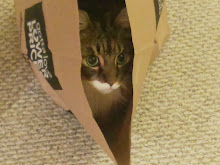The name comes from a comment one of my friends made as I was working on it, she said the contrasting color looked like barbed wire. It's created on the bias, with simple increases/decreases to cause the stripes to be slanted. I learned the general bias technique at a Lili Chin workshop.
If you don't know of a group in your areas that needs blankets, I'd highly recommend checking out Project Linus, whose mission is "to provide love, a sense of security, warmth and comfort to children who are seriously ill, traumatized, or otherwise in need through the gifts of new, handmade blankets and afghans, lovingly created by volunteer 'blanketeers.'"
Barbed Biased Blanket
Skill Level – Easy (pattern uses basic increases and decreases) Finished Size – Approximately 43 x 65 inches. Size can be modified by gauge or numbers or stitches/rows.
Materials
Worsted Weight (category 4) yarn in 2 or more colors.
Size K / 6.5 mm hook.
Tapestry needle.
I used Red Heart Super Saver in 4 colors – black as main color and dark gray (3 strips), blue (2 strips), and gray-blue (2 strips) as contrasting colors. Colors could be changed to suit the individual. I'd recommend one main color with multiple contrasting colors or multiple main colors with one contrasting color to unify the blanket.
Gauge
Gauge isn't critical to this project.
My gauge was 13.5 stitches equals 4 inches. Row pattern (4 MC rows and 2 CC rows) equals 3 inches high.
Pattern Instructions
Special Stitches
MC = main color
CC = contrasting color
fsc = foundation single crochet
dc2tog = double crochet two together (decrease)
Strips – make 7, or as many as desired.
Row 1 (MC): 19 fdc, turn.
Row 2 (MC): ch 3, dc in same stitch and in each across to last 2 stitches, dc2tog, turn. [19 dc]
ch 3 counts as dc throughout pattern.
Row 3 (MC): ch 3, dc in next stitch and in each across, turn. [19 dc]
Row 4 (MC): ch 3, dc in next stitch and in each across, turn. [19 dc]
Row 5 (CC): ch1, sc in same stitch, *ch 1, skip stitch, sc* across to end, turn. [10 sc, 9 ch1-spaces]
Row 6 (CC): ch1, sc in same stitch, *ch 1, skip stitch, sc* across to end, turn. [10 sc, 9 ch1-spaces]
Row 7 (MC): ch 3, dc across, into sc and ch1-spaces. [19 dc]
Work rows 8 – 12 the same as rows 2-6.
Repeat rows 7-12, until there are 21 MC/CC sections, or as many as desired.
Work rows 7 – 10 one more time, so that the strip begins and ends with the MC.
Assembly
Attach the decrease side of one strip to the increase side of another, so that the CC stripes are misaligned (they will slant on a bias). The edges won't align completely, part of the strip will stick out into a slight point, due to the bias nature of the strip.
I joined my strips by slip stitching in one strip, ch 1, slip stitch in other strip (down from the other sl st, not directly across).
Edging
 After the strips are joined together, work sc edging around the entire afghan. On the top and bottom, there will be slight points on one side of each strip. Work sc on the part of the edge sticking out from the other strip and work 2 sc into each corner/point stitch.
After the strips are joined together, work sc edging around the entire afghan. On the top and bottom, there will be slight points on one side of each strip. Work sc on the part of the edge sticking out from the other strip and work 2 sc into each corner/point stitch.This is my first published pattern, so there may be inadvertent errors. Please reach out to me if you have questions or suggestions for improvements. I'd love to see your finished blankets!!




